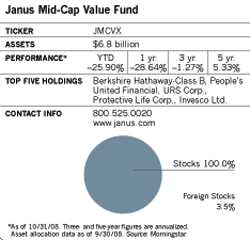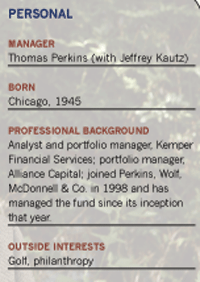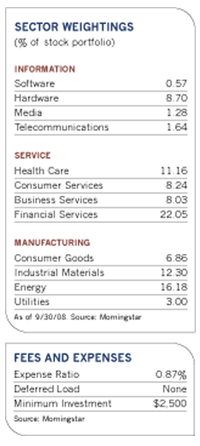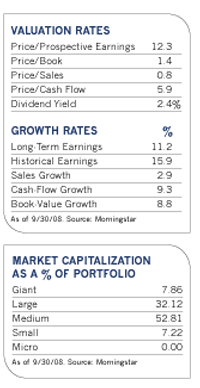It's the day after the worst week in stock market history, a period when the Dow lost nearly 2,400 points in just eight days of trading. Even though the benchmark is up over 900 points at the close of trading, marking its largest one-day rally ever, Tom Perkins is not feeling very optimistic.
"All bets are off until credit loosens up," observes the 63-year-old manager of the Janus Mid-Cap Value fund. "The government and the Fed are throwing everything they've got into the problem and eventually it will work. The question is when. In the meantime, we're getting seat-of-the pants responses rather than a comprehensive, cohesive plan."
He remains guarded as the damage works its way through the system. "The economy is going to struggle for years to come, and there is not going to be much economic growth. The stock market will continue to have violent drops and rallies. I don't think we're going to see anywhere near normal returns over the next couple of years."
Although stocks are relatively inexpensive by some measures, Perkins believes that what looks cheap now may not look that attractive going forward, and does not view the market downturn as a tremendous buying opportunity. "This is a different economy than most people have faced in a lifetime," he says. "I expect that near-term earnings could be a lot worse than most analysts predict."
Perkins is no stranger to investing during a struggling economy. During his first four months in the business in 1974 as an analyst and portfolio manager at Chicago's Kemper Financial, the stock market lost nearly one-third of its value. For the most part, stocks flopped around in the ensuing years until the early 1980s, when the long bull market began.
But Perkins learned that even if the market isn't doing well, certain stocks can defy the odds. The returns for the overall market during the late 1970s mask the fact that small and midcap stocks did pretty well, he points out. He also learned some lessons in tough-time investing from Kemper founder John Hawkinson, who cut his teeth in the investment business during the Depression and who valued strong balance sheets, cash flows and consistent management above all else. Perkins put those principles into practice during his 14 years at Kemper, where he was an investment research analyst and manager of the firm's insurance equity and convertible bond holdings before moving to Alliance Capital, where he oversaw $3 billion in equity assets.
Today, he continues to focus on solid, out-of-favor companies whose stocks are down considerably only because of near-term disappointments or a temporary tough patch, and whose businesses are resistant to economic downturns. "These are not turnaround situations where a company is beaten down and bringing in new management," he emphasizes. "In fact, longtime, proven management is one of the things we look for." Other favorable characteristics include strong cash flow and low debt levels.
He does not believe in making concentrated, issue-specific bets, and it is rare for a single position in this fund of 153 holdings to account for more than 2% of portfolio assets. The portfolio's annualized turnover rate of 95% is about average for a mutual fund, but much of that comes from Perkins' penchant for "trading around" favored stocks for years by buying them on dips and selling when they have hit their price targets. Despite the fund's turnover, Perkins' strategy of offsetting capital gains with losses has made the fund one of the more tax-efficient in Morningstar's midcap value category.
When Perkins doesn't see anything he likes, he won't buy. Unlike many equity funds, this one is not committed to being fully invested at all times and has at times held between 10% and 20% of its assets in cash equivalent investments. Last year, the fund implemented a new strategy of using index put options as a portfolio hedge.
While such caution has kept Janus Mid-Cap Value from shooting the lights out in bull markets, longtime shareholders probably aren't complaining. Since its inception over ten years ago, the fund has had only one calendar year of negative returns. With an average annual return of 15% over the ten-year period ended September 30, it was the 27th best performing fund in the Morningstar equity universe over the period and the second-best performing midcap value offering. The performance attracted attention from mutual fund giant Janus, which now has an 80% stake in Perkins' Chicago-based firm.
Perkins, whose 75-year-old brother Robert founded Perkins, Wolf, McDonnell and Company in 1984, has ample incentive to keep returns strong, taxes low and risk at bay. Robert and his son Todd, who run the Janus Small Cap Value Fund, have much of their own money in the firm's mutual fund charges, as do Tom Perkins and his 35-year-old son Alec, one of ten analysts at the firm. The fund's performance-based management fee provides added incentive, even though its 0.87% expense ratio is well below the 1.4% average ratio for funds in Lipper's midcap value category.
"We don't expect this fund to top the charts on a yearly basis, but over time its disciplined style will benefit long-term-oriented investors," writes Morningstar analyst Andrew Gogerty. "While management keeps it simple by seeking stocks with low valuations, it also spends a significant amount of time estimating what could go wrong with a potential investment."
As he did when he first entered the investment business in 1974, Perkins, who has managed the fund since its inception in 1998 and worked with co-manager Jeff Kautz since 2002, continues to look for bulletproof companies whose stocks are attractively priced relative to a company's growth potential. Although the fund is classified as a midcap offering, its weighted average market capitalization is $14.5 billion and it owns a broad mix of companies. Nearly 40% of its equity assets are in large companies with market capitalizations of more than $10 billion, while companies with market caps of $5 billion to $10 billion account for 17% and smaller companies with $1 billion to $5 billion worth of outstanding stock represent 42% of assets.
"We often buy stocks that aren't institutional favorites, and we go where the best values are," he says. Although he points out that the fund has done well in the past with small and midcap stocks, he believes that "large caps could outperform in a tougher environment, but you need to be selective."
Citing some of the favored stocks in the portfolio, his list begins with a group of familiar names, including Berkshire Hathaway and PepsiCo. Berkshire chairman Warren Buffett has recently received attention for scooping up large equity stakes in struggling companies. In early October, Berkshire announced it will invest $3 billion in the preferred stock of General Electric, which has a generous 10% dividend yield, and receive warrants to purchase $3 billion in common stock. The announcement followed on the heels of large deals with Constellation Energy and Goldman Sachs. Even though Buffett is in his eighties, Perkins believes there are a number of solid candidates at the company to succeed him.
Fund holding PepsiCo has also been in the news recently after it said it would cut 3,300 jobs, or 1.8% of its global workforce, and shutter six of its plants in an effort to save $1.2 billion. The announcement followed a 9.5% drop in third-quarter profits, well below Wall Street expectations, which furthermore came with a pessimistic outlook for the fourth quarter. Perkins acknowledges that these issues may hurt the company in the short term, but he also thinks PepsiCo has a great franchise and the stock is "not excessively priced."
Less-well-known holdings in his portfolio include Connecticut-based People's United Financial, an off-and-on fund holding for the last five years. Unlike many of its competitors, this bank has managed to avoid the subprime mortgage mess. Also, it is located in a state with the highest per capita income level in the country and has ample cash and a strong balance sheet. The stock was down just 7% from its 52-week high as of mid-October. Another bank holding, BBT Bank, operates mainly in the Southeast and has been a fund holding for about a year. Despite a high-quality loan portfolio and a strong balance sheet, the stock declined sharply last year as earnings fell and troubles in the banking industry dragged it down. As of mid-October, the stock had nearly doubled from its 52-week low, and it sports a 5% dividend yield.
Although the fund's dividend yield recently exceeded 4%, the generous payout is largely a byproduct of the down market. "We look at dividends as a risk reducer. While they certainly provide some comfort level, the goal here is total return," Perkins says.












